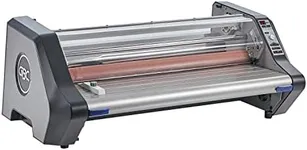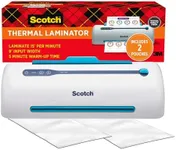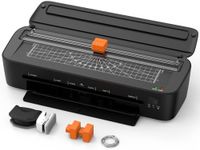Buying Guide for the Best Thermal Laminators
Choosing the right thermal laminator can make a big difference in the quality and durability of your laminated documents. Whether you need it for home, school, or office use, understanding the key specifications will help you make an informed decision. Here are the main factors to consider when selecting a thermal laminator.Laminating SpeedLaminating speed refers to how quickly the laminator can process documents, usually measured in inches per minute (IPM). This is important because a faster laminator can save you time, especially if you have a lot of documents to laminate. Laminators with speeds of 9-12 IPM are suitable for occasional use, while those with speeds of 13-18 IPM are better for moderate use. For heavy-duty or professional use, look for laminators with speeds above 18 IPM. Consider your typical workload to determine the right speed for you.
Maximum Document SizeThe maximum document size a laminator can handle is crucial, as it determines the largest item you can laminate. This is usually specified in terms of width. Common sizes include 9 inches for standard letter-sized documents, 12 inches for larger documents, and up to 27 inches for posters and wide-format items. If you primarily laminate standard documents, a 9-inch laminator will suffice. For larger projects, opt for a laminator that can accommodate wider materials.
Warm-Up TimeWarm-up time is the duration it takes for the laminator to be ready for use after being turned on. This is important because a shorter warm-up time means you can start laminating sooner. Warm-up times can range from 1 minute to 10 minutes or more. For occasional use, a longer warm-up time might be acceptable, but for frequent or professional use, look for a laminator with a warm-up time of 3 minutes or less to minimize waiting.
Thickness CapacityThickness capacity refers to the maximum thickness of the laminating pouches the machine can handle, usually measured in mils (thousandths of an inch). This is important because thicker pouches provide more protection. Common thicknesses are 3 mil, 5 mil, and 10 mil. For everyday documents, 3 mil pouches are sufficient. For items that need more durability, such as ID cards or frequently handled documents, 5 mil or 10 mil pouches are better. Choose a laminator that supports the thickness you need for your projects.
Number of RollersThe number of rollers in a laminator affects the quality and consistency of the lamination. More rollers generally mean better pressure distribution and fewer bubbles or wrinkles. Laminators typically have 2, 4, or 6 rollers. For basic use, a 2-roller laminator is adequate. For higher quality and more consistent results, especially for thicker pouches or frequent use, a 4-roller or 6-roller laminator is preferable. Consider the importance of lamination quality in your projects when choosing the number of rollers.
Jam Prevention FeaturesJam prevention features help avoid or resolve paper jams, which can be a common issue with laminators. These features are important because they save time and reduce frustration. Some laminators have reverse functions to back out jammed pouches, while others have sensors to detect and prevent jams. If you are new to laminating or plan to use the machine frequently, look for a laminator with robust jam prevention features to ensure smooth operation.




















